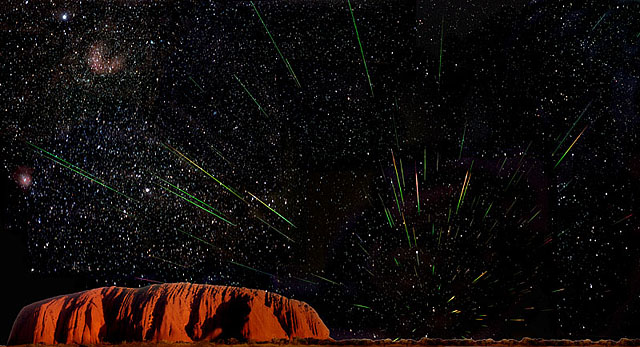 |
|
|
[ Nasa Prediction ] [ Itinerary] [India & Jaipur] [ Nepal ] [ Leonid Circumstances] [ Hotels] [Terms] [ Astrotours 2009 ] [ Astrotours 2010 ]
|
|
 |
|
|
The best place on earth to watch the The map above shows the locations on earth where the radiant of the Leonid shower will be above the horizon while still dark, at the time of the predicted outburst. Areas darkened out will not see the radiant above the horizon during dark hours. Coastlines and country borders are outlined in white. The colors shown reveal statistical maps of clear sky in the month of November. Red = 0-20% mean cloud cover. Orange = 20-30% cloud cover. Our northern India destination affords an 80% probability of seeing the meteor shower. Our selection of Jaipur vs. other locations in India included the air quality of Jaipur vs. other locations on our itinerary, and the location of this specific hotel 17km outside the main basin of Jaipur. A hilly terrain is present and we feel this will help isolate our position from light pollution and smog from the Jaipur area. A sky brightness map of India is available here, our hotel is located in the yellow zone, with a predicted visual limiting magnitude of 6.0. Sunset is 5:35PM local time (UT+5.5h), with the new Moon setting just a few minutes later at 5:48PM. The fireworks should begin at about midnight with the rise of the radiant in the constellation Leo. Peak of the outburst will be from 2:30-4:00 AM local time. The Leonid radiant at maximum will have an altitude of 41 degrees, with azimuth 83 degrees (approximately east). Meteors will continue to be visible until morning twilight begins at 5:30AM. Sunrise will be at 6:49AM. The 2009 Leonids meteor shower outburst will be caused by an encounter with dust streams laid down by comet 55P/Tempel-Tuttle in the years 1466 and 1533. The 1466 stream was proven to be rich during the 2008 encounter. This is the end of the Leonid storms for now; the next encounter with any Leonid stream that could produce heightened rates will be in 2033. The 1533 stream will make its next return in 2043. The 1466 stream will not be seen again in our lifetime. Those who wish to observe for a few hours before bed may do so. Others may want to stay up all night and observe until dawn. We have the morning free for a late sleep or choice to return to the observatory for more time before continuing day touring later in the afternoon. It is not necessary to check out of the hotel the next day, so those who stay up all night may hang a "do not disturb" sign and recover their sleep. |
 Expert leaders: This expedition will be led by world known expert meteor shower astro-photographers, Jen Winter of www.icstars.com and Fred Bruenjes of www.moonglow.net Their body of work is among the most published imaging of meteor showers and storms in the world, thanks to their unique style of capturing dozens if not hundreds of meteors in one image. Their images have been published as numerous book covers, online from NASA to APOD, published in Newsweek Magazine and on the Discover Magazine blog site. Here are just a few of their notable images and publishings: |
